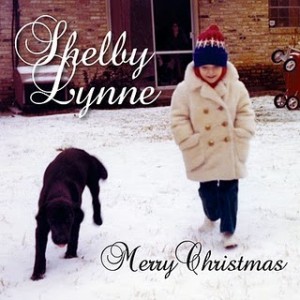 In recent years, Shelby Lynne has made intimate music her calling card. When she recorded Just a Little Lovin’ in 2008, she sang an album’s worth of Dusty Springfield songs as if she was alone in her bedroom singing to her mirror. On Merry Christmas (Everso), she comes out of her shell to celebrate the season her way. Her performance is scaled up to an audience of dozens, with a band that does exactly what’s needed, made up of exactly the right number of pieces for each song. The resulting precision and space frame the songs and clear the room for Lynne’s voice, which always sounds almost casual, but never so much so that you lose sight of the artist behind it.
In recent years, Shelby Lynne has made intimate music her calling card. When she recorded Just a Little Lovin’ in 2008, she sang an album’s worth of Dusty Springfield songs as if she was alone in her bedroom singing to her mirror. On Merry Christmas (Everso), she comes out of her shell to celebrate the season her way. Her performance is scaled up to an audience of dozens, with a band that does exactly what’s needed, made up of exactly the right number of pieces for each song. The resulting precision and space frame the songs and clear the room for Lynne’s voice, which always sounds almost casual, but never so much so that you lose sight of the artist behind it.
Here’s Lynne talking about Merry Christmas:
Why make a Christmas record?
I’ve been in the business for 22 years; it was time to make a holiday record. It’s something I’ve always wanted to do; I took the opportunity, now that I have my own label.
Are Christmas records good business?
I guess I’ll find out.
What plans did you have when you started making the record?
Just to keep it simple and conventional. No surprises. It’s one of my pet peeves to hear Christmas music taken out of its traditional way. I’m a full believer in making it your own, but keeping it in the same service as the original tune.
One of the things I admire about the album is how simple the arrangements are.
The songs are so beautiful. Too much takes away. I want something people can play in the background and enjoy and want to hear over again.
What Christmas records do you remember from your childhood?
We didn’t have any Christmas records around the house. We just always sang Christmas songs. When I got older, I loved Ella Fitzgerald, Sinatra, Elvis, of course. I even like Barbara Streisand. But my favorite is the Vince Guaraldi Trio (who wrote and performed the soundtrack for Merry Christmas, Charlie Brown).
What’s the appeal of “Christmas Time is Here” for a singer?
It’s a beautiful melody. I went to look for the words when I recorded it; I wasn’t sure it had any. It actually has a lot of words. So I just sing a couple of verses of it, kept it short. That’s another thing—I don’t like is draggin on and on with tunes. Unless you really have something to say, it’s better just to keep it simple. Unless you’re doing a Bob Dylan tune, keep it simple, move on to the next things.
I’m not sure I know anyone over seven or eight who likes “The Twelve Days of Christmas”.
That’s one of my not-so-favorites. (laughs)
How did you choose the songs for this albums?
Really, just the ones that were my favorites and the first that came to mind. I hear holiday music now and I say, “Damn, I wish I’d cut that!” Maybe somewhere down the line I’ll do another one because it’s certainly fun. It’s kind of a no-brainer: It’s fun, and you do it for yourself, something that you can be proud of. Everybody’s always looking for new holiday music.
When did you record it?
In June, in the California desert. When you’re in a dark studio you can kind of pretend like you’re everywhere. When we first started playing the music, you kind of disappear in the music. Christmas music is so powerful, it takes you there.
What about it is so powerful?
I think it’s probably has to do with the fact that it unites us in some way, us as a people. Whether you’re Christmas or Jewish or whatever, it’s the holiday season. Like the music at any other time of year, music is something that brings us all together. Christmas music especially is pretty powerful because it reminds you of a time. It’s something you feel in your soul.
When you sing a spiritual Christmas song, are you thinking of it as an overt statement of Christian faith, or is there something else going on?
Well yeah, absolutely I am. I think there’s a certain reverence in spirituals I try to convey when I sing a song. If there’s one thing I can’t do, it’s fake it. That why I was very careful when I chose the two that I chose. As far as the spiritual songs, “O Holy Night” is one of the greatest ones. And then “Silent Night” talks about the little baby Jesus. There’s so many of them, you know, but I didn’t want to get lost in that. I didn’t want to deal with a bunch of people asking me about the Christian songs. It’s supposed to be a joyful time, not a heavy time. Sometimes religion takes you to a heavy place.
You wrote two songs for this. What were the challenges about writing a Christmas song?
The challenges are to not think about it too much, and just write what’s in the soul. “Ain’t Nothin’ Like Christmas” is just what it is: It’s just fun, it doesn’t mean anything, it’s kind of silly. It’s about a bunch of drunks getting together and having a good time at Christmas. And the other one (“Xmas”) is an honest tune about how Christmas is not always so much fun. Sometimes the memories can cut you pretty deep. Everything I say in that song’s true. We can all try to pretend like Christmas is all mistletoe and around the tree, but sometimes it’s not.
“Christmas Time is Coming” – who did the first version of that?
I don’t know who did it. I don’t even know why I did it. I just though it would be good with just the vocal and an upright bass.
Are there songs that stand out as country Christmas songs?
I don’t know. “Christmas Time is Coming” is one. I thought I’d cut that because it’s a “everybody who’s got a guitar and everybody that sings, come on let’s get together and sing it” song, and that’s how I recorded it. Everybody that was in the studio played something. This is not a serious time; let’s just all get in the key of G and go. Sing, and play, and everybody take a solo. It’s supposed to be like passing the jug around and having a good time because that’s pretty much what was happening when we cut it.
How long were you in the studio working on this?
I don’t know, a week.
Is that fast for you?
I really don’t think it takes that much more time if you’re prepared, just go in there and cut it. I mean, how good is it going to get? Go in there, do it a couple of times, pick the best one. I don’t slave over records. I don’t want to be completely sick of them when they come out.
There aren’t a lot of backing vocals. Was that a choice, or just what was in the studio?
Well it just didn’t call for anything more. I felt like I put them where they needed to be. This is my philosophy on making records. Let the record breathe, have air and space. There’s nothing wrong with swirling around space and air on a record. You don’t have to put the kitchen sink on it. Most of the time if you just leave it alone, it’ll do the feeling for you. You can produce records to death, and then you suck the life out of them. Sometimes it’s good to let the listener go, “Well, I don’t feel overcrowded.” That’s simple and gets the point across by just being emotional in a simple way.
That seems to suit you.
I really appreciate a great melody and a great lyric, and what good is it if you can’t hear it? I’m a studio nerd. I love making records, and all that gear, all that stuff that you could fool around with for eons. You can work a record to death, but another challenge is to just leave it alone. There’s nothing wrong with just doing a vocal and a guitar if that’s all it takes. And if something’s calling for a little help, I’m certainly there to lend to lend a voice or throw some three-part harmony on there. But sometimes it gets too overbearing. I have to keep musicians at bay when I make records: “Hey, wouldn’t this sound good?”
“That’s why you’re not the producer.”
“Sleigh Ride/Winter Wonderland” is the only place I put sleigh bells on. You’re so tempted in every song because it’s such a feel-good instrument, but I really kept the reins tight and kept my bells only on the intro part of the record. It kind of sets up the mood, but it doesn’t kill you, like, “Oh, there are the bells again.”
[youtube]http://www.youtube.com/watch?v=_F0NxomV6l4&feature=player_embedded#![/youtube]




